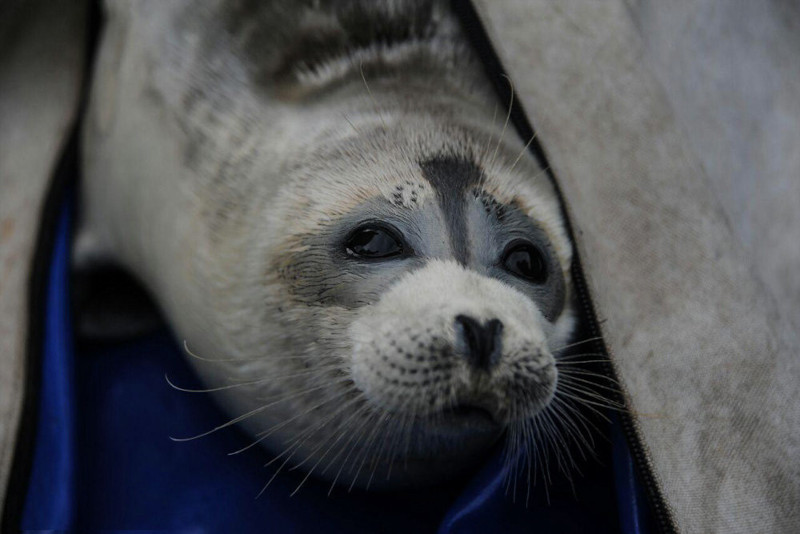Caspian Seal Facts
- This beautiful small mammal, unique in a surprising way, most frequently goes by the informative common name of the Caspian Seal. Unlike many of its relatives, this intriguing creature does not, for the moment, at least, have another general name.
- Among scientific professionals, such as researchers, however, it’s typically referred to by its official name. Fortunately for the layperson, that’s an extremely simple term, as such things go. That’s because it holds the technical moniker of the Pusa caspica.
- The animal received that official name due to the work of the respected German naturalist, Johann Friedrich Gmelin. He recorded the first official recognition of the pinniped as a separate and distinct species. He further accomplished this in 1788.
- Regardless of the name one chooses to employ, though, it remains a remarkable work of Nature and evolution. Evidence also suggests an intriguing origin for the creature. It’s thought to be descended from ringed seals trapped in the region by melting ice sheets.
- Sadly, its population, already limited by the nature of its range, appears to be declining. The principal reason for this seems to be a virus spreading through its population. Due to these factors, the IUCN currently lists the mammal as Endangered on its Red List.
- The amazing animal also faces other threats, as well. These include intentional human activities, such as hunting. Commercial ice-breaking routes also disturb important areas of their range. It’s additionally endangered by climate change, as most species.
Related Articles
Leopard Seal
Caspian Seal Physical Description
The amazing Caspian Seal quickly draws the attention of those fortunate enough to encounter it. It does so, however, for reasons other than sheer physical size. That’s because this particular seal, despite its other fascinating attributes, ranks as one of the smallest seals.
Like many of its kind, and indeed most species, it displays a moderate degree of the physiological characteristic of sexual dimorphism. In its case, though, this trait manifests itself in terms of pure physical size. Otherwise, the two genders appear virtually identical.
Overall, males of the distinctive pinniped tend to develop as slightly larger and bulkier in physique. Mature males average around 190 lb (86 kg) in weight. Although exceptional individuals do occur, of course, even they rarely exceed this amount by any great percentage.
In general, physicall mature specimens attain a body length of 50 – 51 in (126 – 129 cm). The genders also display different growth patterns. Females begin life somewhat smaller than males, but reach full growth more quickly. Males take 30 – 40 years, females just 10.
The tantalizing Caspian Seal also displays a visually appealing color pattern. This primarily consists of a background of gray. That, however, varies from light to dark, between individuals. The stomach also tends to display a very light gray, almost off-white, coloring.
Individuals of both genders also distinguish themselves from related creatures in another way. This species possesses comparatively short flippers. The front flippers typically develop moderate-sized claws. Shorter, narrower one’s however, usually manifest on the rear flippers.
- Kingdom: Animalia
- Phylum: Chordata
- Class: Mammalia
- Order: Carnivora
- Family: Phocidae
- Genus: Pusa
- Species: P. caspica
Caspian Seal Distribution, Habitat, and Ecology
The beautiful Caspian Seal evolved as native to a region of the world already well known for its abundance of natural wonders. Unfortunately for it, though, it developed in a highly restricted portion of this region. This area lies between the continents of Europe and Asia.
That particular area, however, holds an interesting distinction. The very name of the animal further provides a clear indication of that precise zone of habitation. That’s because the impressive mammal lives exclusively in and around the waters of the Caspian Sea.
Although its overall range is limited, it typically makes the most of what it has available. That’s due to the fact that individuals and groupings alike appear in many different parts of the region. These inhabit the shoreline, rocky islands, and floating blocks of ice equally.
It does tend to remain in shallower regions, though. Most specimens rarely dive to depths greater than 160 ft (50 m). Occasionally, however, scattered individuals go much deeper. The greatest depth of dive ever recorded for this specific species reached 540 ft (165 m).
Much like its relatives, the Caspian Seal feeds as a carnivore. In its case, this consists primarily of various locally available varieties of fish. During certain periods of the year, though, many individuals also consume moderate quantities of differing small crustaceans.
Throughout most of the year, this wonder of Nature lives a mainly solitary life. The exception occurs during mating season, of course. Following an 11-month gestation period, the female generally gives birth to a single pup. A typical lifespan also equals 50 years.
Species Sharing Its Range
Check out our other articles on 3 Awesome Antarctic Land Species, Northern Flying Squirrel, Victoria Falls, Magnolia Green Jumper, Lau Banded Iguana, American Wintergreen, Weedy Seadragon

